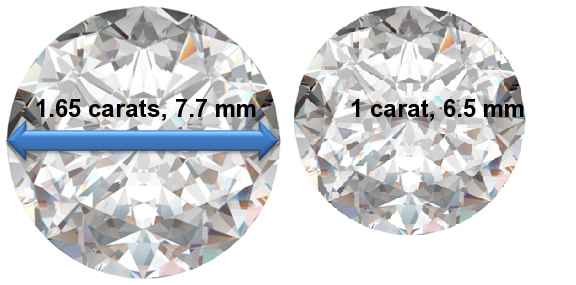Quick and Easy Buying Guide
Carat weight: 1 carat = 200 milligrams = 6.5 mm diameter. Doubling weight doesn't double diameter.
Diamond clarity: FL/IF/VVS/VS = super expensive, near perfect. SI = best value if you can check a photo for obvious inclusions (defects).
Color: D-G = colorless, expensive, only if you have money to burn. H-J = best value. Can go lower in gold metal settings than white metal.
Cut: Better cut ratings let more light into a diamond, making it sparkle more. Very important property, don't skimp here.
Set a budget and minimum cut (Premium). Go J color for gold and I/H for white metals. Go searching for SI1/SI2 clarity diamonds at James Allen. Pick a diamond with small/no inclusions. Choose a ring setting and buy it risk-free (60-day returns).
1.65 Carat Diamonds
Searching for 1.65 carat diamonds? Well, make sure you also use the term "165" point diamonds when you look on the internet using google or other search engines. The width of a diamond with a weight of 1.65 carats is about 7.73 mm.
Sponsored Links
Although there is a strong correlation between the carat weight of a diamond and its width, this does not guarantee that every 1.65 carat diamond is 7.73 mm wide.
In evaluating the value of a 1.65 carat diamond, one thing you can do is work out the precise cost per carat of diamond. Don't be fooled into considering only the carat size, because other factors such as the size of the diamonds girdle can significantly impact on the apparent size of the diamond, which is more important than the carat weight (apart from for bragging rights).
The apparent size of a diamond does not increase at the same rate as the diamond's carat size, leading to confusion quite often in stores. Savvy diamond buyers have learnt to search for diamonds that do not have round numbers in their carat weight - for example, these buyers will search for a diamond with the carat weight just below one or two carats.

If you're umming and ahhing about whether to get a diamond or another precious gemstone, a relevant piece of information regarding their carat size is that the stones have varied densities, leading to different sizes for stones of the same weight. There are no firm statistics that are universally applicable, but it is generally agreed that the average size of a diamond is around a third of the carat, perhaps a little more.
Looking around the internet at online diamond stores, you may be tempted to think that a four or five carat diamond is large. You couldn't be more wrong - the golden jubilee diamond is an example of how big diamonds can really be - it is 545 carats, or a weight of more than 100 g, which is about a quarter of the weight of a can of coke. If you're in a store and you've found a ring which you're interested in, but only the total diamond weight is marked, don't hesitate to ask a shop assistant. They should give you the individual diamond weights, and if they don't just walk away - it's not worth your time dealing with unscrupulous sellers.
In terms of diamond properties, the carat weight of the diamond should be considered alongside the many other characteristics of the diamond, in order to find a diamond which is balanced and hence not let down by being of poor quality in one of these departments.
Performance stands out like a ton of diamonds. Non performance can always be explained away. Harold S. Geneen .

